Gradient Structure of the Transfer Layer in Friction Stir Welding Joints
Abstract
:1. Introduction
2. Experimental Procedure
2.1. Materials and Experimental Setup
2.2. Investigative Techniques
3. Results and Discussion
3.1. Metallography
3.2. Scanning Electron Microscopy
3.3. Transmission Electron Microscopy
3.4. Microhardness Measurements
3.5. Structural Evolution Pattern
4. Conclusions
- 1.
- It was shown for the first time that the transfer layer has a gradient structure. The grain size, the volume fraction and size of incoherent intermetallic particles decrease towards the center of the layer, while the volume fraction of semi-coherent secondary particles increases.
- 2.
- The gradient structure of the transfer layer is confirmed by microhardness measurements. The microhardness increases towards the center of the transfer layer.
- 3.
- The onion ring structure formation during friction stir welding explained by a mass transfer mechanism. According to the mechanism, the tool transfers some material from the front to the rear. The material interacts with the previous layer. Friction occurs between the layers, leading to heat generation. As a result, the microstructure at the layer boundaries changes.
- 4.
- As the plunge force increases, the grain size also increases due to increasing heat generation. The gradient of structure in the transfer layer is preserved in this case.
- 5.
- Ultrasonic treatment slightly affected the grain structure, but led to a change in the phase structure. In particular, ultrasound reduced the size and volume fraction of secondary particles across the entire layer thickness. The microhardness of the weld material decreased, probably due to a decrease in residual stresses.
Author Contributions
Funding
Institutional Review Board Statement
Informed Consent Statement
Conflicts of Interest
References
- Mishra, R.S.; De, P.S.; Kumar, N. Friction Stir Welding and Processing; Springer International Publishing: Cham, Switzerland, 2014; ISBN 978-3-319-07042-1. [Google Scholar]
- Guerra, M.; Schmidt, C.; McClure, J.C.; Murr, L.E.; Nunes, A.C. Flow Patterns during Friction Stir Welding. Mater Charact 2002, 49, 95–101. [Google Scholar] [CrossRef]
- Schneider, J.A.; Nunes, A.C. Characterization of Plastic Flow and Resulting Microtextures in a Friction Stir Weld. Metall. Mater. Trans. B 2004, 35, 777–783. [Google Scholar] [CrossRef]
- Yan, J.H.; Sutton, M.A.; Reynolds, A.P. Processing and Banding in AA2524 and AA2024 Friction Stir Welding. Sci. Technol. Weld. Join. 2007, 12, 390–401. [Google Scholar] [CrossRef]
- Tarasov, S.Y.; Filippov, A.V.; Kolubaev, E.A.; Kalashnikova, T.A. Adhesion Transfer in Sliding a Steel Ball against an Aluminum Alloy. Tribol. Int. 2017, 115, 191–198. [Google Scholar] [CrossRef]
- Yang, C.L.; Wu, C.S.; Lv, X.Q. Numerical Analysis of Mass Transfer and Material Mixing in Friction Stir Welding of Aluminum/Magnesium Alloys. J. Manuf. Process 2018, 32, 380–394. [Google Scholar] [CrossRef]
- Kalashnikova, T.; Chumaevskii, A.; Kalashnikov, K.; Fortuna, S.; Kolubaev, E.; Tarasov, S. Microstructural Analysis of Friction Stir Butt Welded Al-Mg-Sc-Zr Alloy Heavy Gauge Sheets. Metals 2020, 10, 806. [Google Scholar] [CrossRef]
- Zykova, A.; Chumaevskii, A.; Gusarova, A.; Gurianov, D.; Kalashnikova, T.; Savchenko, N.; Kolubaev, E.; Tarasov, S. Evolution of Microstructure in Friction Stir Processed Dissimilar CuZn37/AA5056 Stir Zone. Materials 2021, 14, 5208. [Google Scholar] [CrossRef] [PubMed]
- Acharya, U.; Roy, B.S.; Saha, S.C. Effect of Tool Rotational Speed on the Particle Distribution in Friction Stir Welding of AA6092/17.5 SiCp-T6 Composite Plates and Its Consequences on the Mechanical Property of the Joint. Def. Technol. 2020, 16, 381–391. [Google Scholar] [CrossRef]
- Liu, X.C.; Wu, C.S. Material Flow in Ultrasonic Vibration Enhanced Friction Stir Welding. J. Mater. Process Technol. 2015, 225, 32–44. [Google Scholar] [CrossRef]
- Kim, Y.G.; Fujii, H.; Tsumura, T.; Komazaki, T.; Nakata, K. Three Defect Types in Friction Stir Welding of Aluminum Die Casting Alloy. Mater. Sci. Eng. A 2006, 415, 250–254. [Google Scholar] [CrossRef]
- Eliseev, A.A.; Kalashnikova, T.A.; Filippov, A.V.; Kolubaev, E.A. Material Transfer by Friction Stir Processing. In Multiscale Biomechanics and Tribology of Inorganic and Organic Systems; Springer: Cham, Switzerland, 2021; pp. 169–188. [Google Scholar]
- Zuo, L.; Zuo, D.; Zhu, Y.; Wang, H. Effect of Process Parameters on Surface Topography of Friction Stir Welding. Int. J. Adv. Manuf. Technol. 2018, 98, 1807–1816. [Google Scholar] [CrossRef]
- Mironov, S.; Sato, Y.S.; Kokawa, H. Grain Structure Evolution during Friction-Stir Welding. Phys. Mesomech. 2020, 23, 21–31. [Google Scholar] [CrossRef]
- Frigaard, Ø.; Grong, Ø.; Midling, O.T. A Process Model for Friction Stir Welding of Age Hardening Aluminum Alloys. Metall. Mater. Trans. A 2001, 32, 1189–1200. [Google Scholar] [CrossRef]
- Eliseev, A.A.; Kalashnikova, T.A.; Gurianov, D.A.; Rubtsov, V.E.; Ivanov, A.N.; Kolubaev, E.A. Ultrasonic Assisted Second Phase Transformations under Severe Plastic Deformation in Friction Stir Welding of AA2024. Mater. Today Commun. 2019, 21, 100660. [Google Scholar] [CrossRef]
- Genevois, C.; Fabrègue, D.; Deschamps, A.; Poole, W.J. On the Coupling between Precipitation and Plastic Deformation in Relation with Friction Stir Welding of AA2024 T3 Aluminium Alloy. Mater. Sci. Eng. A 2006, 441, 39–48. [Google Scholar] [CrossRef]
- Alinaghian, I.; Honarpisheh, M.; Amini, S. The Influence of Bending Mode Ultrasonic-Assisted Friction Stir Welding of Al-6061-T6 Alloy on Residual Stress, Welding Force and Macrostructure. Int. J. Adv. Manuf. Technol. 2018, 95, 2757–2766. [Google Scholar] [CrossRef]
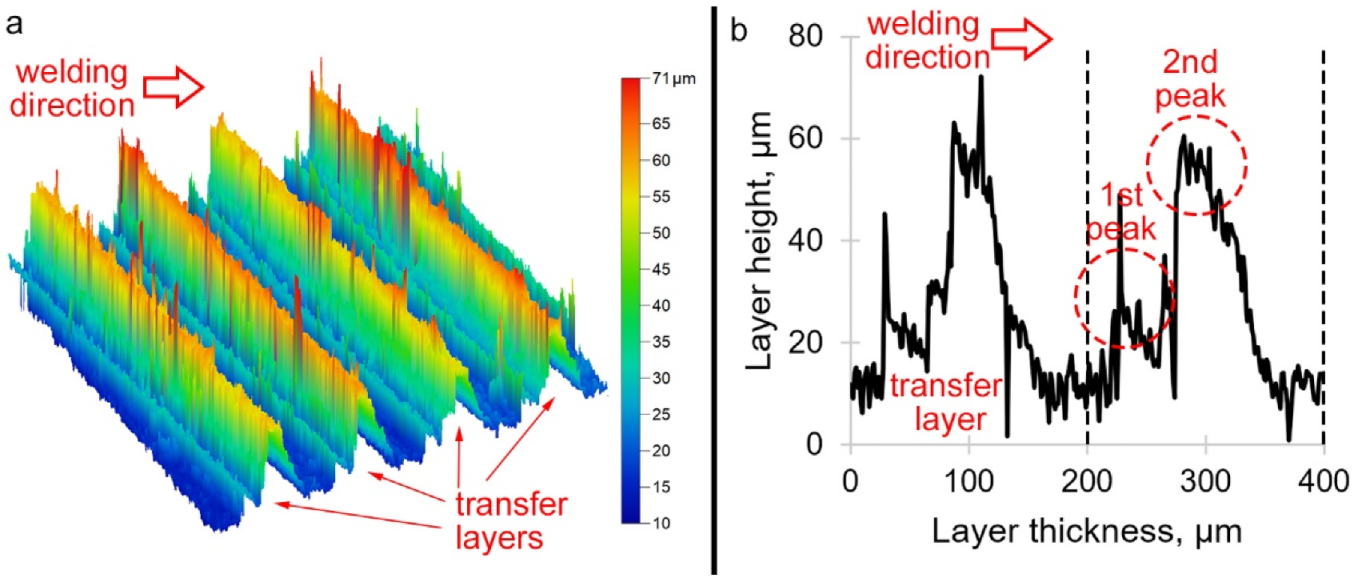



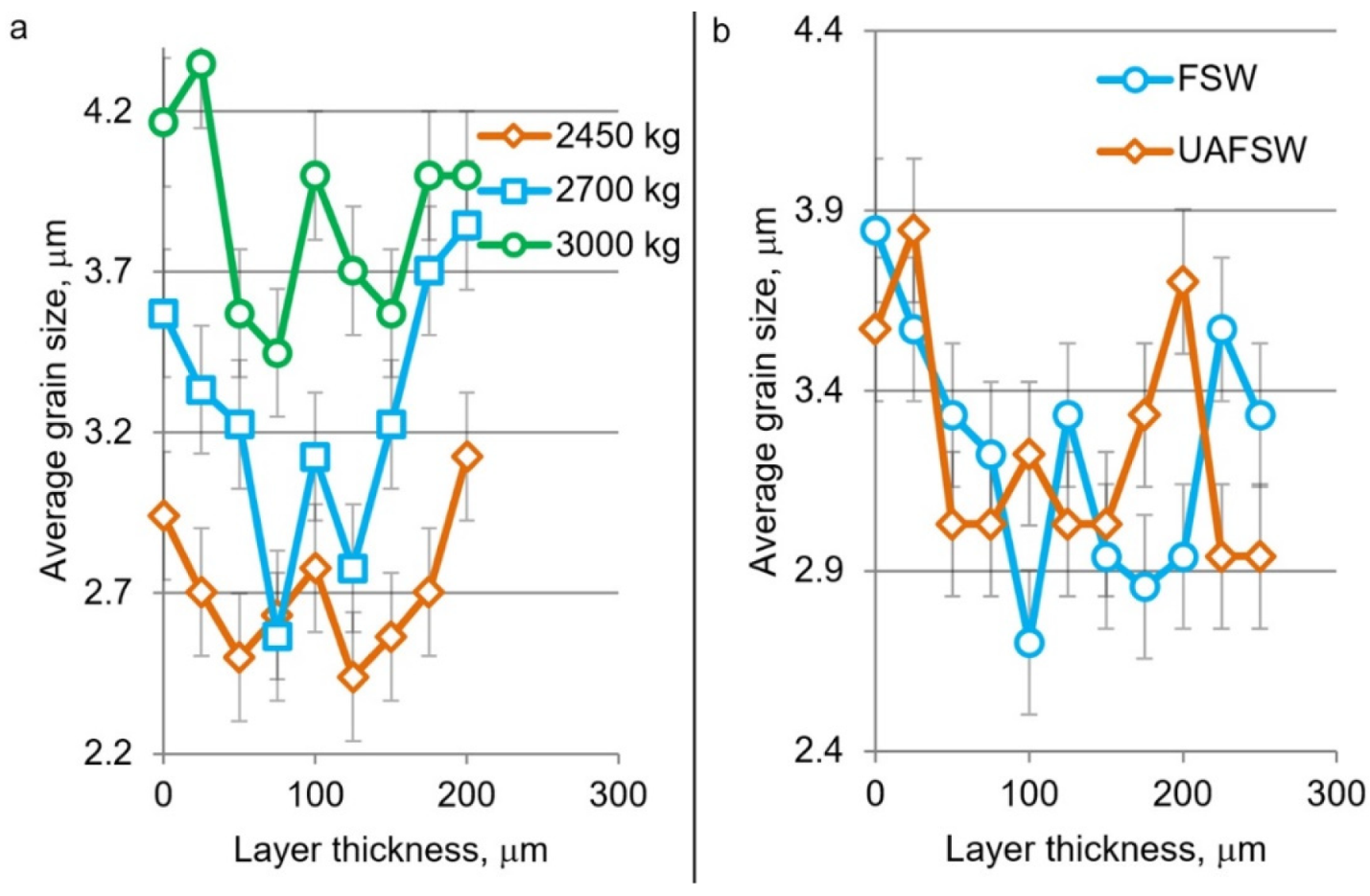

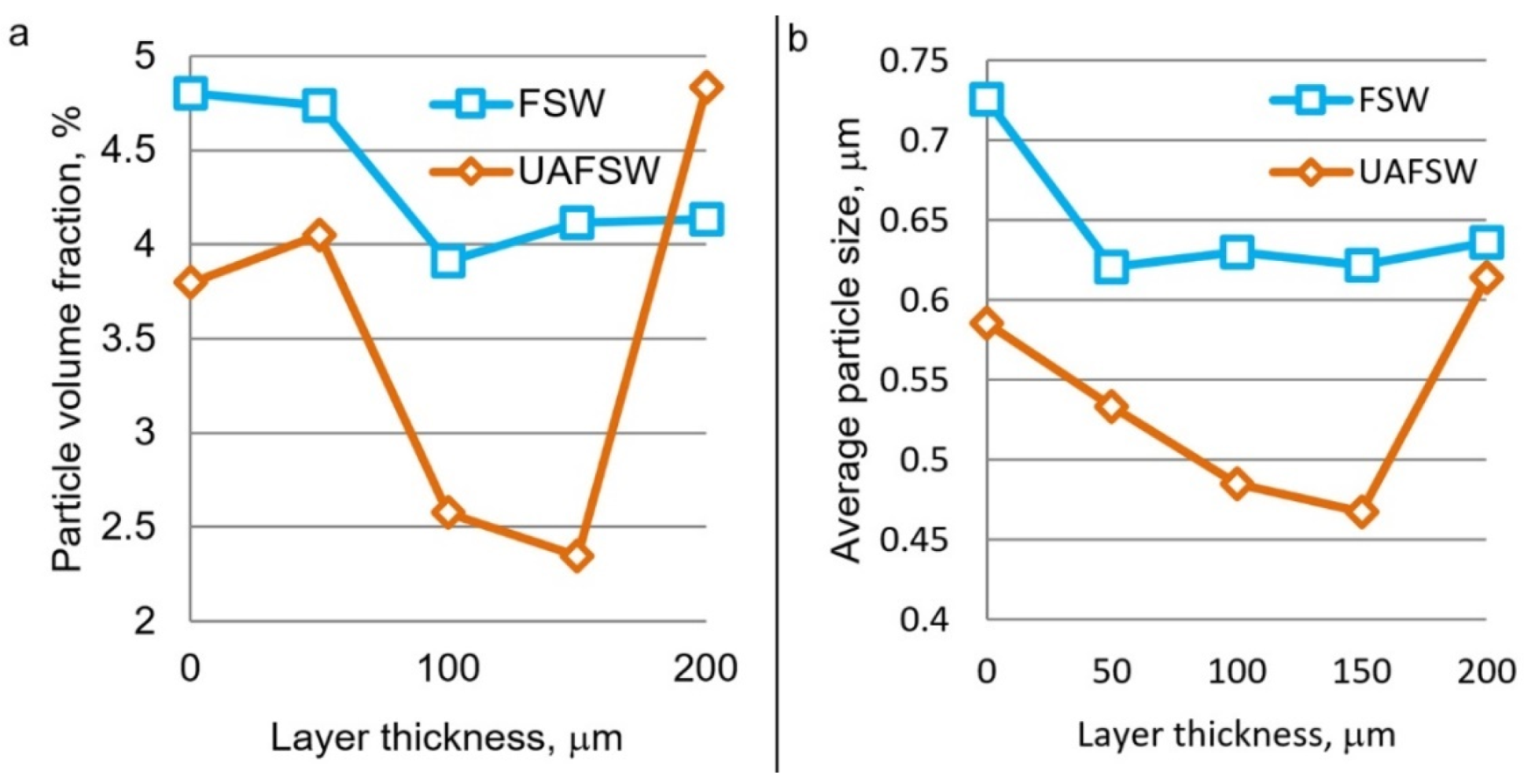
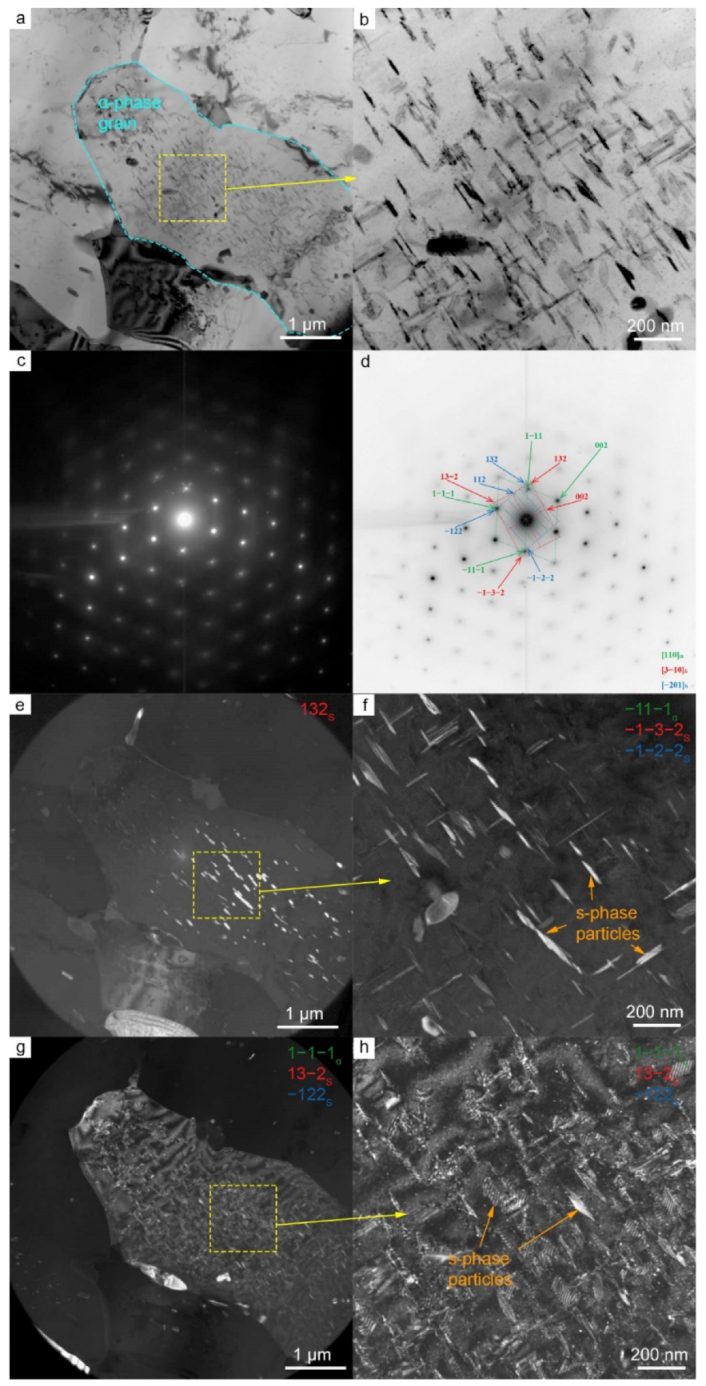
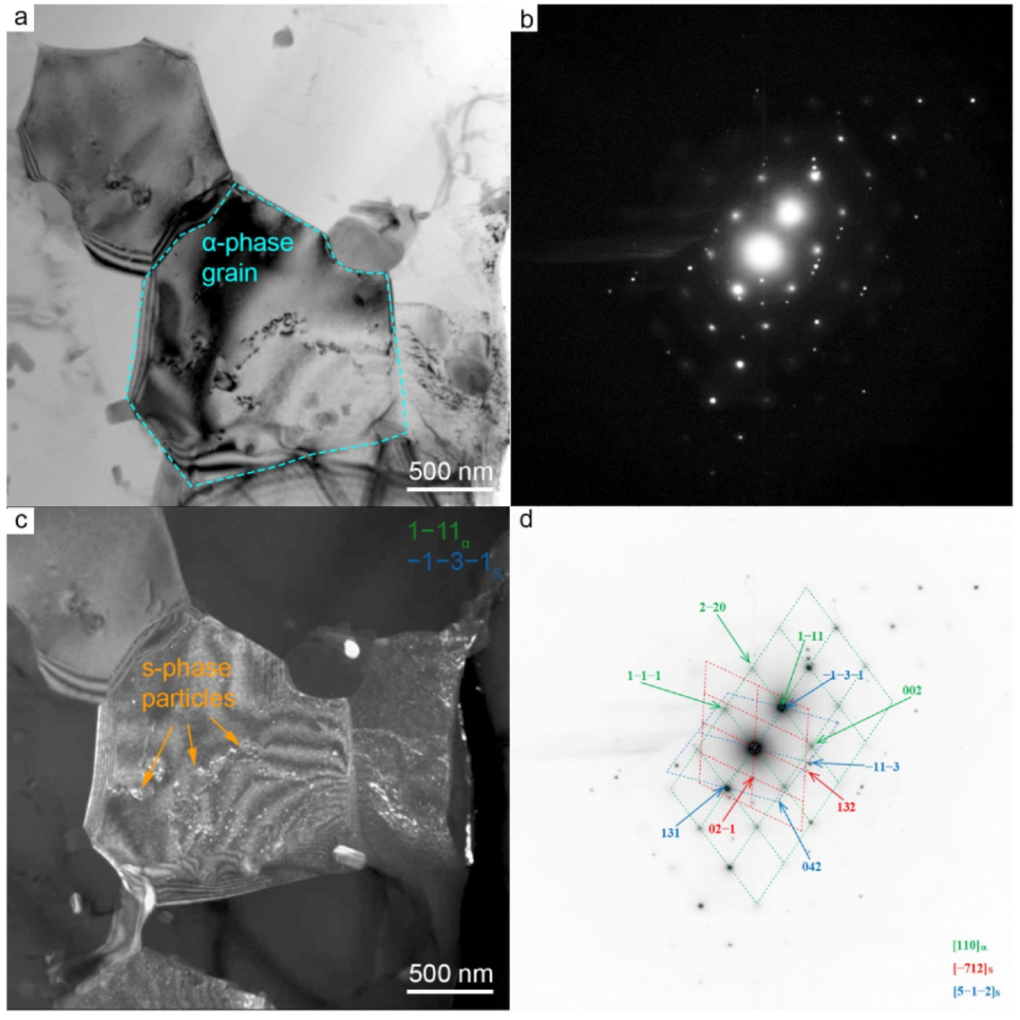

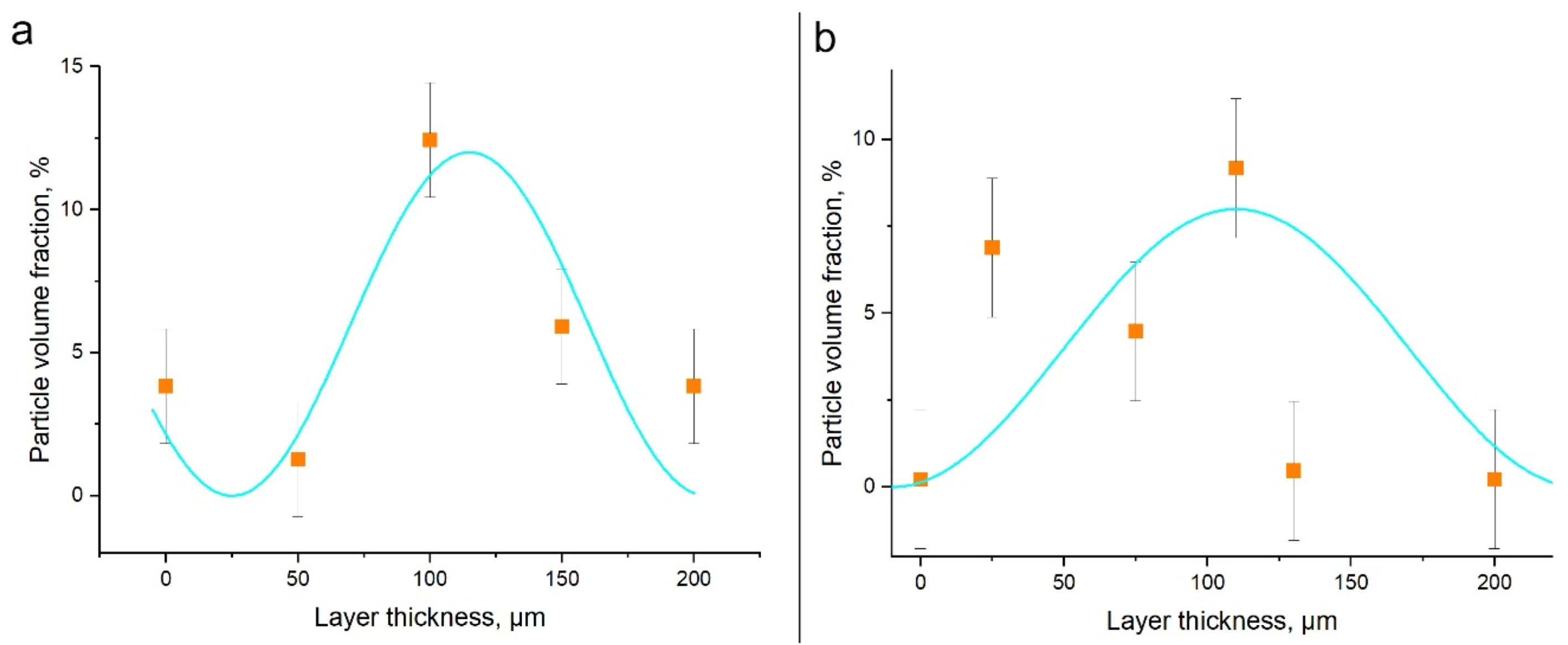
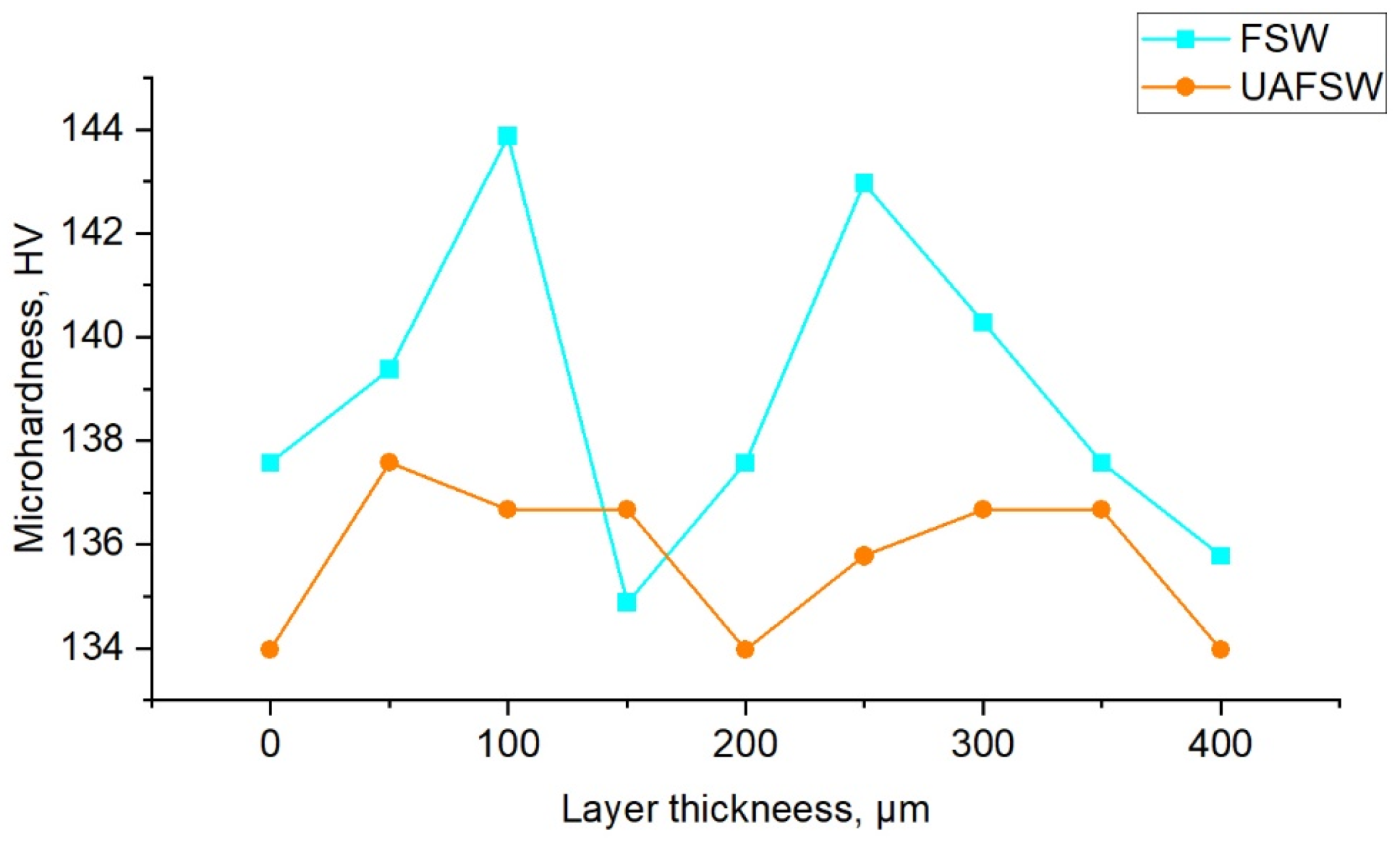
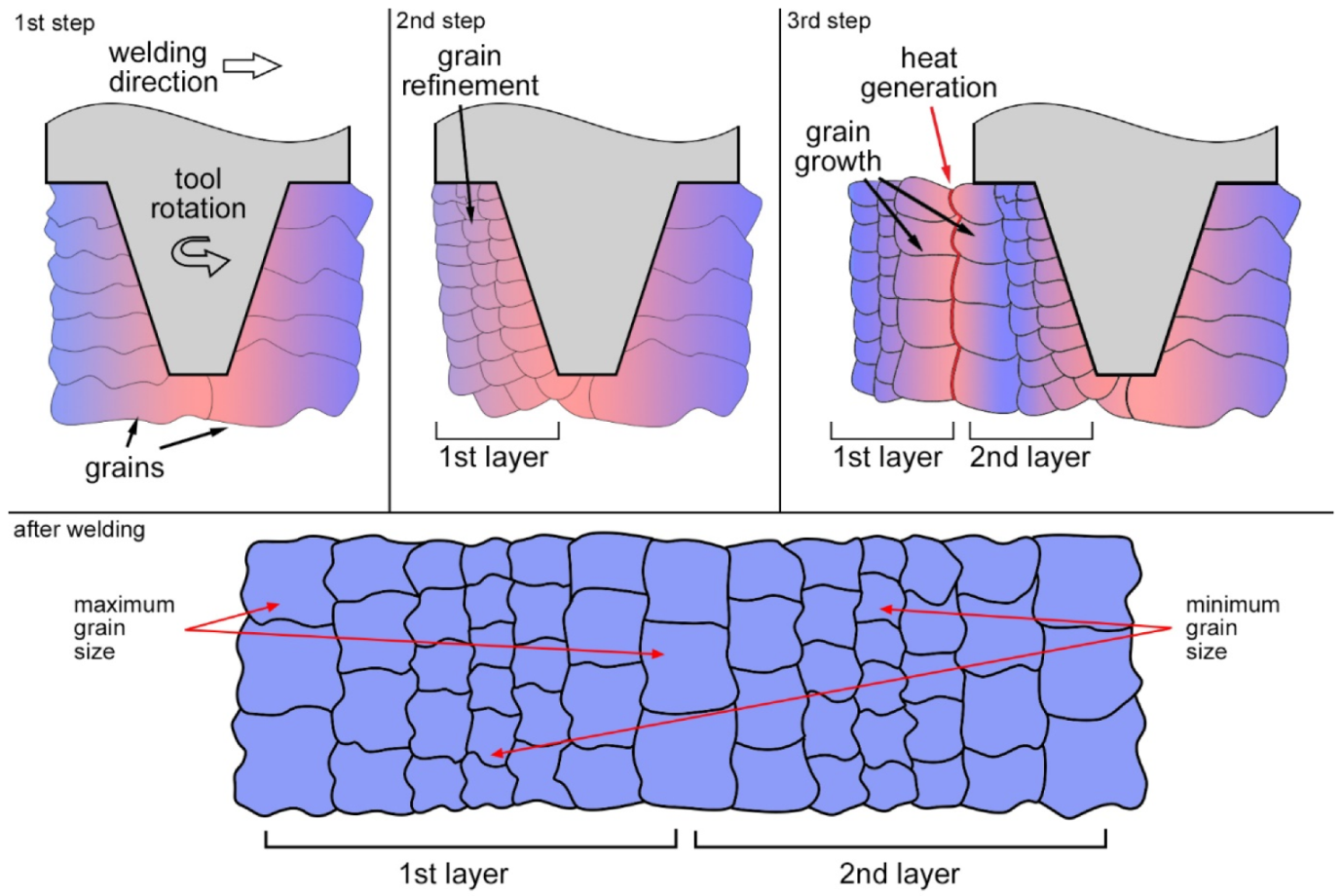
Publisher’s Note: MDPI stays neutral with regard to jurisdictional claims in published maps and institutional affiliations. |
© 2022 by the authors. Licensee MDPI, Basel, Switzerland. This article is an open access article distributed under the terms and conditions of the Creative Commons Attribution (CC BY) license (https://creativecommons.org/licenses/by/4.0/).
Share and Cite
Eliseev, A.; Osipovich, K.; Fortuna, S. Gradient Structure of the Transfer Layer in Friction Stir Welding Joints. Materials 2022, 15, 6772. https://doi.org/10.3390/ma15196772
Eliseev A, Osipovich K, Fortuna S. Gradient Structure of the Transfer Layer in Friction Stir Welding Joints. Materials. 2022; 15(19):6772. https://doi.org/10.3390/ma15196772
Chicago/Turabian StyleEliseev, Alexander, Kseniya Osipovich, and Sergei Fortuna. 2022. "Gradient Structure of the Transfer Layer in Friction Stir Welding Joints" Materials 15, no. 19: 6772. https://doi.org/10.3390/ma15196772




